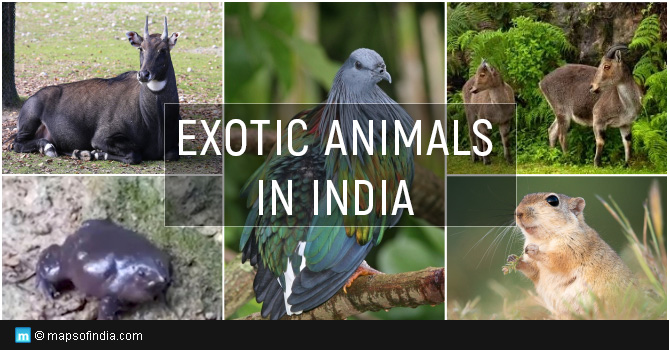India is the abode to various animals and plant species. But due to climatic changes or human activities, some animals are on the verge of extinction. The Government of India has established 103 National Parks, 543 Wildlife Sanctuaries, 73 Conservation Reserves, and 45 Community Reserves to protect wildlife in India.
To know more about some of the exotic animals found in India, check out the list below:
Nilgiri Tahr
Nilgiri Tahr is also known as the Nilgiri Ibex or simply ibex in the local area. It can be found in the Nilgiri hills and also in the Southern portion of the Western Ghats in the states of Tamil Nadu and Kerala in Southern India. Nilgiri Tahr is the state animal of Tamil Nadu. The total population of this animal is around 3000. They come under the category of endangered species and there are 2 reasons for it. First is the illegal poaching and hunting of this animal and another is the Eucalyptus cultivation which has hampered the dwelling of these animals in their natural habitat. The population of these animals is still witnessing a significant drop despite the efforts to conserve them.
Purple Frog
The Purple Frog, also known as the Pignose Frog or the Indian Purple Frog, is a recently discovered species of frog. These type of frogs are extremely difficult to identify in the first glance. They usually live underground and it has been observed that they come over the surface only during monsoons which is also their mating period. The purple frog forages its food underground, they don’t emerge to the surface in search of food. They can be found only in the Western Ghats and Palghat Gap region. They use their tongue and a special buccal groove to procure their food and feed mainly on termites.
Nicobar Pigeons
Nicobar Pigeons are much more colorful than the other pigeons which you see everywhere. They are one of the most unique, attractive, and colorful species of pigeons ever found in India. Nicobar pigeons are the only living members of the genus Caloenas and the closest living relative of the extinct Dodo and extinct Rodriguez Solitaire. This species of pigeons are found in coastal regions from the Andaman and Nicobar Islands, India, east through the Malay Archipelago, to the Solomons and Palau and on small nearby islands. They have a grey head but their body is very colorful and unmatched. Nowadays illegal hunting of this beautiful bird is taking place for its meat and gizzard stone, which is used in jewelry. They are near-threatened species as per IUCN.
Nilgai
The Nilgai or the blue bull is the largest Asian antelope. This animal is endemic to the Indian subcontinent. Nilgai has white facial spots and sturdy thin legs. It also has a deep white neck with a white patch on its throat. It is characterized by a short crest of hair along the neck terminating in a tuft and a column of pendant coarse hair which hangs from the dewlap ridge below the white patch. Females are orange or tawny while males have a bluish grey coat. Only males have horns. The lifespan of a Nilgai on an average is about ten years. They can be found in Terai lowlands in the foothills of the Himalayas (northern India).
Indian Desert Jird
The Indian Desert Jird or Indian Desert Gerbil is an inhabitant of desert and barren areas which prefer firm soil. They can never be located in pure sand dunes or rocky outcrops. They are the rodents which come under the category of jirds and are closely related to gerbils. They are mainly found in the Thar Desert region of India (mainly in the states of Rajasthan and Gujarat). Their prime food is seeds, roots, grasses, nuts, and insects. They can be distinguished from other rodents as they have short ears, long black claws, and orange incisors. Indian Desert Jird is 12–14 centimeters (4.7–5.5 in) long and has a 10–15 cm (3.9–5.9in) long tail and grey-brown coat with a yellowish-grey belly.




